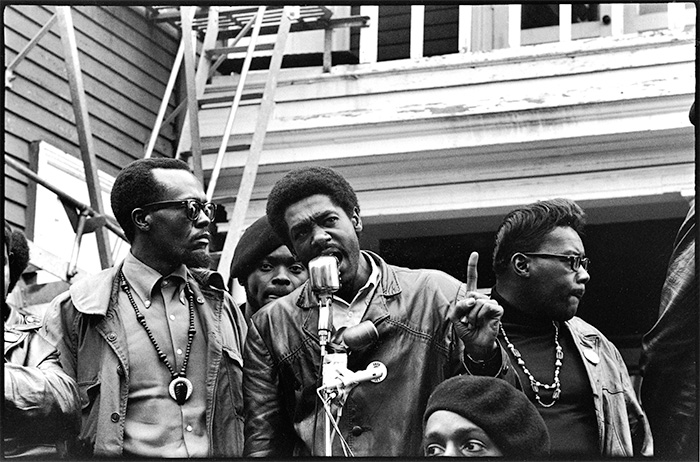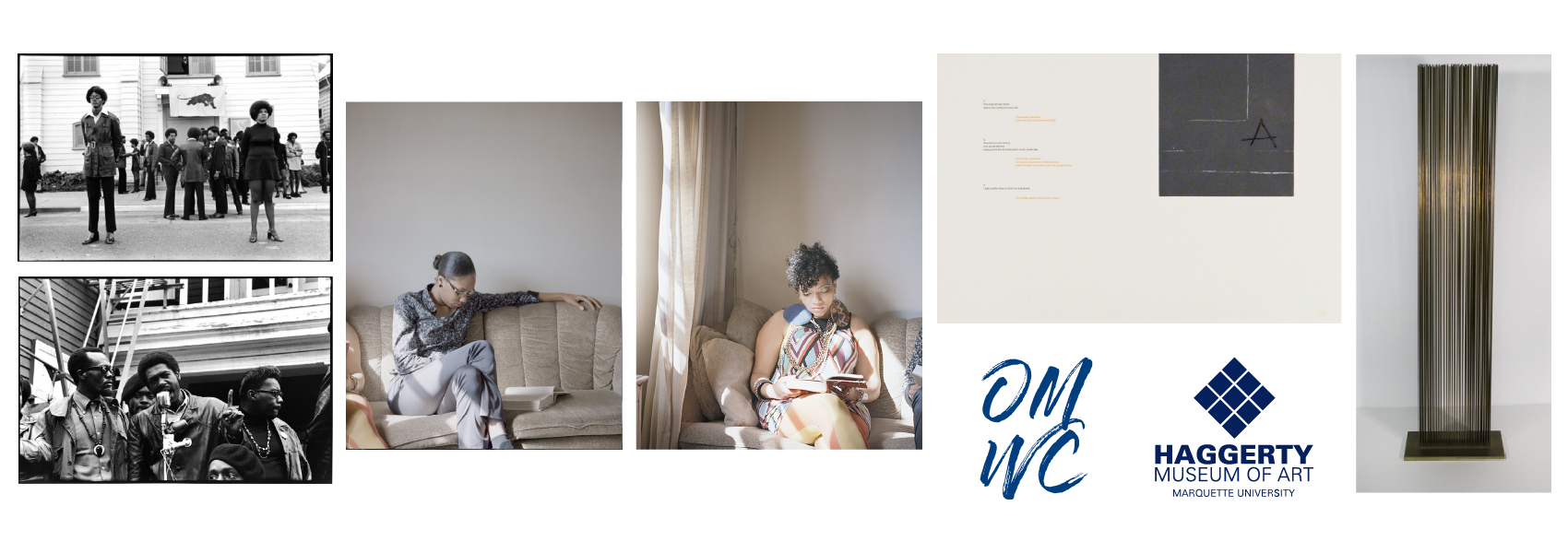February: Black History and Heritage Month
Black History and Heritage Month invites all of us to learn about and celebrate the achievements of Black Americans past and present. In tandem with Marquette's February Mental Health Day, #BHM also invites us to celebrate the work of Black artists, writers, and thinkers, especially those who have dedicated their lives to our collective liberation and well being.

Both of these photos by Stephen Shames are on view at the Haggerty Museum of Art as part of the exhibition Exploring the Core – Crossing Boundaries: The Movement of People, Goods, and Ideas.
Photographer Stephen Shames was hired by Bobby Seale, Chairman and cofounder of the Black Panther Party, to document the activities of that activist group. Shames explains: “The Panthers were very, very media conscious. They understood how to get the image out there, how to use the media, and how important that is in this day and age.”
Shames' comments say a lot about the power of the visual. Consider the visual choices that he made in these photographs. Who did he choose to include? How are the pictures organized and composed (group shots, individual shots)? How are the subjects framed (close up, long shot, frontally, from above, from below)? What ideas are communicated by each photo? What emotions do they express and elicit?
Looking Good, Marquette: Art & Writing for Mental Health
Post and tag your writing with #LookingGoodMarquette #BHM #HMA #OttWC
 Stephen Shames, American, b. 1947, Bobby Seale speaks at a Free Huey rally in DeFremery Park. At left is Black Panther Party Captain Bill Brent; at right is Black Panther Party Captain Wilford Holliday (known as “Captain Crutch”). Oakland, 1968, From The Black Panthers Portfolio, Gelatin silver print, Edition 7 / 15, Museum purchase with funds from Mr. and Mrs. Robert L. Pagel, Sr. by exchange
Stephen Shames, American, b. 1947, Bobby Seale speaks at a Free Huey rally in DeFremery Park. At left is Black Panther Party Captain Bill Brent; at right is Black Panther Party Captain Wilford Holliday (known as “Captain Crutch”). Oakland, 1968, From The Black Panthers Portfolio, Gelatin silver print, Edition 7 / 15, Museum purchase with funds from Mr. and Mrs. Robert L. Pagel, Sr. by exchange
5,000 protesters gathered in Oakland, California, on February 17, 1968. That day was Black Panther Party member Huey Newton’s birthday. He spent it in jail awaiting trial for allegedly killing Oakland Police Officer John Frey the previous year.
Prompt 1 (5 minutes)
Look at the positioning of Shames’ camera (below, looking up as if he’s in the front row of the crowd). Where is it focused? (Bobby Seale). Look at Bobby Seale’s eyes. Where is he looking? (He addresses the crowd). Where are the people around him looking? (They look in either direction as if monitoring the situation). What does this suggest about the atmosphere of the event? Why might Shames have framed the photo this way?
Prompt 2 (10 minutes)
Imagine you are in the audience, listening to Bobby Seale. Set a timer for 10 minutes and describe what you see, hear, and feel. Consider where, exactly, you are standing (or sitting or leaning), who is next to you as well as directly in front of and behind you. Along with Seale’s words, what else can you hear: are other people talking? Can you hear traffic sounds or birds or other ambient noises? What does it smell like? How does it make you feel?
 Stephen Shames, American, b. 1947, Glen Wheeler (left) and Claudia Grayson, known as :Sister Sheeba” (right), stand outside George Jackson's funeral at St. Augustine's Church. Oakland, August 1971, From The Black Panthers Portfolio, Gelatin silver print, Edition 7 / 15, Museum purchase with funds from Mr. and Mrs. Robert L. Pagel, Sr. by exchange.
Stephen Shames, American, b. 1947, Glen Wheeler (left) and Claudia Grayson, known as :Sister Sheeba” (right), stand outside George Jackson's funeral at St. Augustine's Church. Oakland, August 1971, From The Black Panthers Portfolio, Gelatin silver print, Edition 7 / 15, Museum purchase with funds from Mr. and Mrs. Robert L. Pagel, Sr. by exchange.
Shames took this photograph at the funeral of George Jackson in 1971. When Jackson was 18, he was accused of stealing $70 from a Los Angeles gas station. Having a record for 2 previous pretty crimes, he was advised by lawyers to plead guilty, with the hope of receiving a light sentence. He was ultimately given a sentence of 1 year to life and spent the next 10 years in prison. He was shot and killed at San Quentin during an attempted prison escape. More than 200 members of the Black Panthers attended his funeral, and thousands of people thronged the nearby streets.
Prompt 3 (5 minutes)
Look at the positioning of Shames’ camera (set back, frontal, waist-high). Look at the framing of the photo. Who occupies the foreground? Who occupies the background? Where are your eyes drawn – multiple places, or to a singular figure? (guards on either side form a visual barrier, but they also frame the group of people at the center as well as the Black Panther banner). Does the picture convey a certain tone or mood? What message might Shames have been trying to send?
Prompt 4 (3 parts, 5 minutes each)
Select someone in the photograph and imagine what they are thinking.
- For part 1, set a timer and write for 5 minutes.
- For part 2, imagine what they are saying (if they are pictured speaking) or would say if they turned to someone near them. Set a time and write for 5 minutes.
- For part 3, imagine what happens next. Set a timer and write about the 5 minutes immediately after the moment Shames captured in this photograph.
Prompt 5 (10 minutes)
“Caring for myself is not self-indulgence, it is self-preservation, and that is an act of political warfare,” wrote Audre Lorde. She was writing from all of her identities, which she listed as “black, lesbian, mother, warrior, poet.” She was also recognizing the importance of self care for each of us individually and for all of us collectively, especially all of us dedicated to the ongoing work of fighting for Black liberation.
Connect the dots between your own activist goals and strategies for self care. Set a timer for 5 minutes and then write about one or more concrete activist goals you have for this semester, the coming summer, or some other time in the near future. When the timer goes off, set it for another 5 minutes and write about specific self-care strategies you can use to help you work toward your goals. Your strategies might be fun or even luxurious (e.g., join a campus club, take Saturday mornings off). Your strategies might be more practical—but no less caring (e.g., make coffee at home on weekdays to save money, go back to therapy). Whatever the case, use this writing time to connect your self-care strategies with your needs and goals as an activist.
Prompt 6 (5 minutes)
In 2015 writer Kleaver Cruz started The Black Joy Project (TBJP). He writes:
I thought about how present I was for and to Black death and pain through my organizing work with various activist collectives in New York City, and the ways I felt bombarded by these things on a daily basis. By the time I woke up that morning, I had already made a commitment to not watch anymore videos of Black death and continue refusing to repost them anywhere on the internet
I decided that my Social media timelines needed some smiles amidst the sharing of important information, thoughts, art, photos and videos that can be upsetting and at its worst depressing and traumatizing. (Kleaver Cruz)
Everyone experiences Black History and Heritage Month differently, from their own positionality and experience.
- If you identify as Black, take 5 minutes to participate in—and even contribute directly to—TBJP. Set a timer and write your joy. Write about small pleasures and big accomplishments, whether yours or others’ in the Black community. When your time is up, consider posting to a picture and a snippet of your writing to IG with the following hashtags: #LookingGoodMarquette #TheBlackJoyProject #BlackFuturesMonth #BlackHistoryMonth #BHM
- If you do not identify as Black, take 5 minutes to write about how you can support as well as celebrate Black joy. Think about ways you can be not only an ally but also an accomplice to participants in this movement without appropriating it. Decide how you can align your own joy or prioritize others’ from your own positionality.




 Stephen Shames, American, b. 1947, Bobby Seale speaks at a Free Huey rally in DeFremery Park. At left is Black Panther Party Captain Bill Brent; at right is Black Panther Party Captain Wilford Holliday (known as “Captain Crutch”). Oakland, 1968, From The Black Panthers Portfolio, Gelatin silver print, Edition 7 / 15, Museum purchase with funds from Mr. and Mrs. Robert L. Pagel, Sr. by exchange
Stephen Shames, American, b. 1947, Bobby Seale speaks at a Free Huey rally in DeFremery Park. At left is Black Panther Party Captain Bill Brent; at right is Black Panther Party Captain Wilford Holliday (known as “Captain Crutch”). Oakland, 1968, From The Black Panthers Portfolio, Gelatin silver print, Edition 7 / 15, Museum purchase with funds from Mr. and Mrs. Robert L. Pagel, Sr. by exchange Stephen Shames, American, b. 1947, Glen Wheeler (left) and Claudia Grayson, known as :Sister Sheeba” (right), stand outside George Jackson's funeral at St. Augustine's Church. Oakland, August 1971, From The Black Panthers Portfolio, Gelatin silver print, Edition 7 / 15, Museum purchase with funds from Mr. and Mrs. Robert L. Pagel, Sr. by exchange.
Stephen Shames, American, b. 1947, Glen Wheeler (left) and Claudia Grayson, known as :Sister Sheeba” (right), stand outside George Jackson's funeral at St. Augustine's Church. Oakland, August 1971, From The Black Panthers Portfolio, Gelatin silver print, Edition 7 / 15, Museum purchase with funds from Mr. and Mrs. Robert L. Pagel, Sr. by exchange.